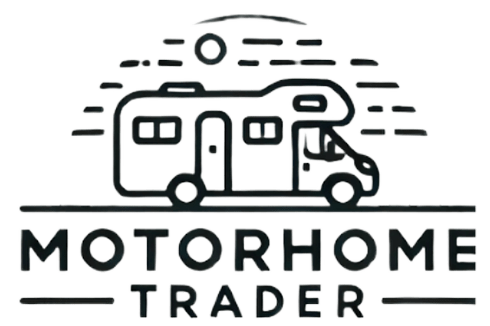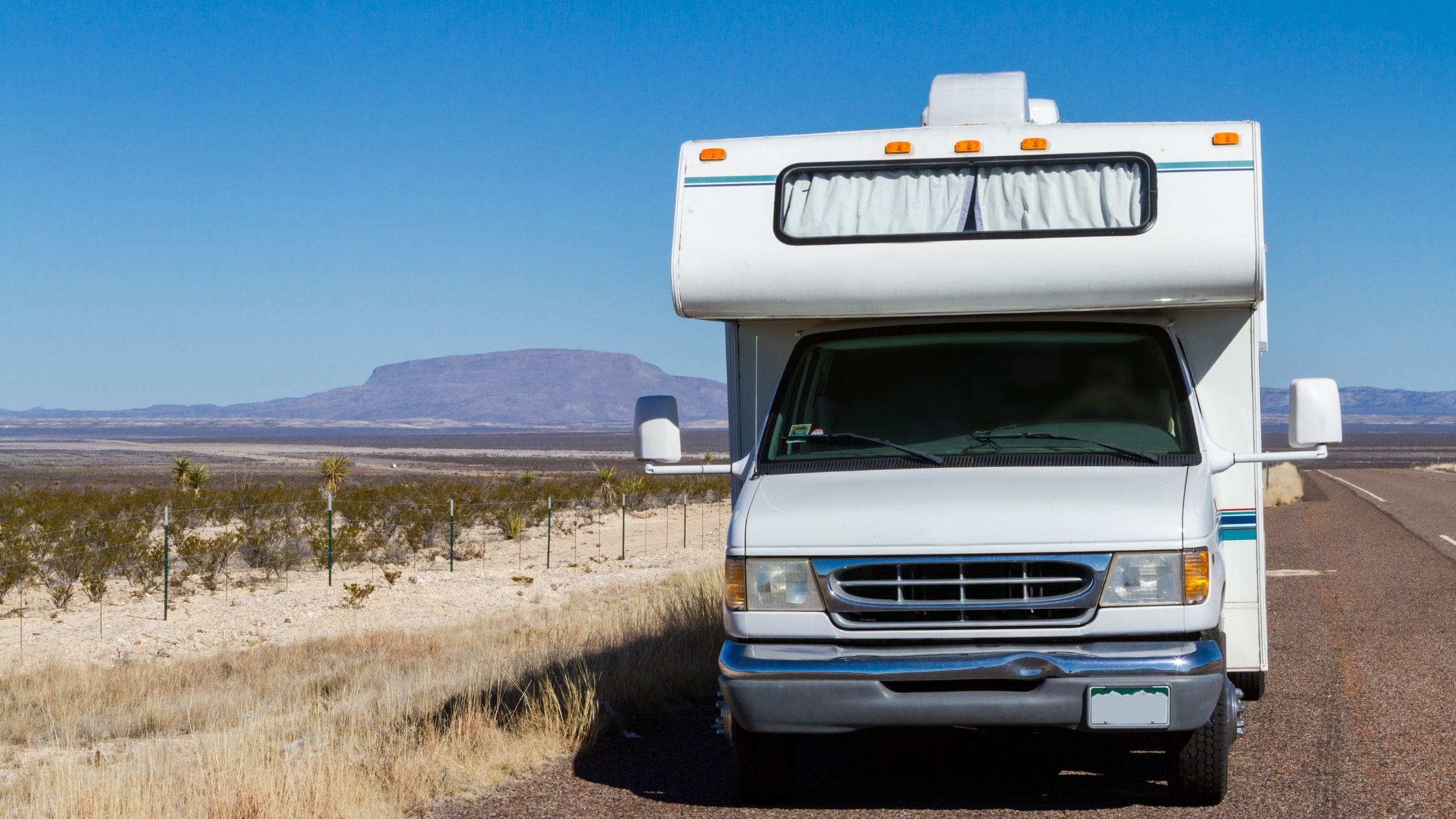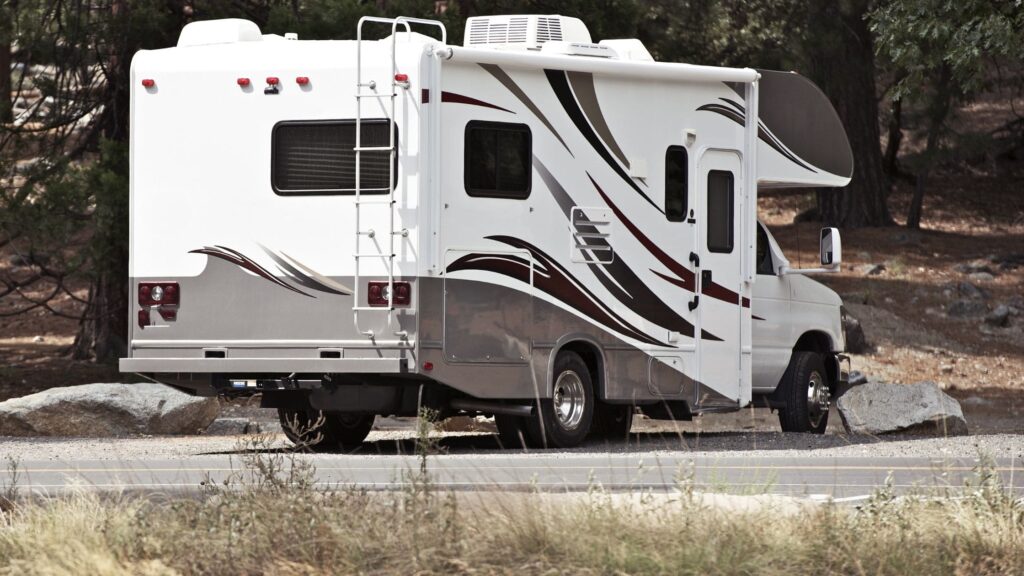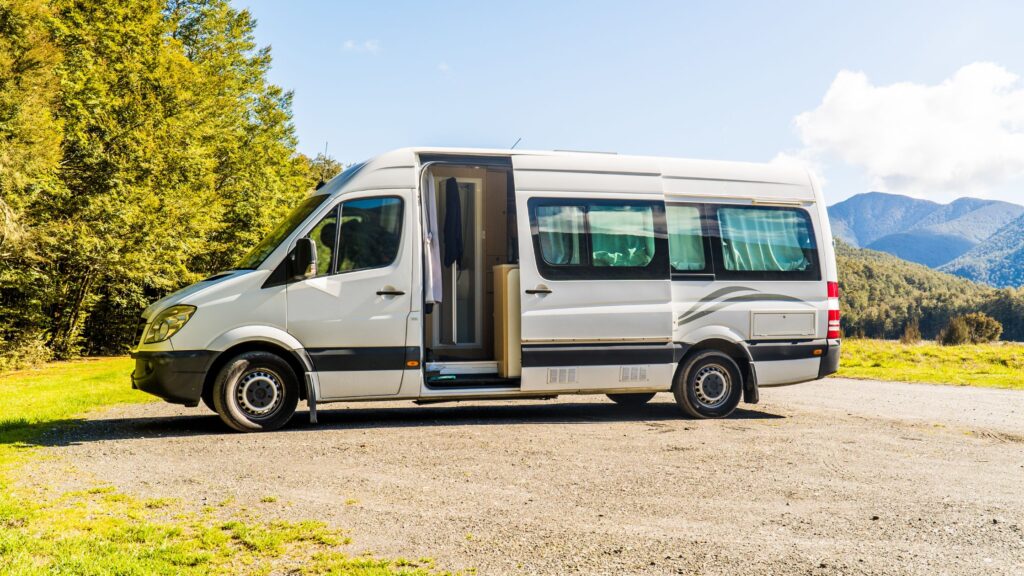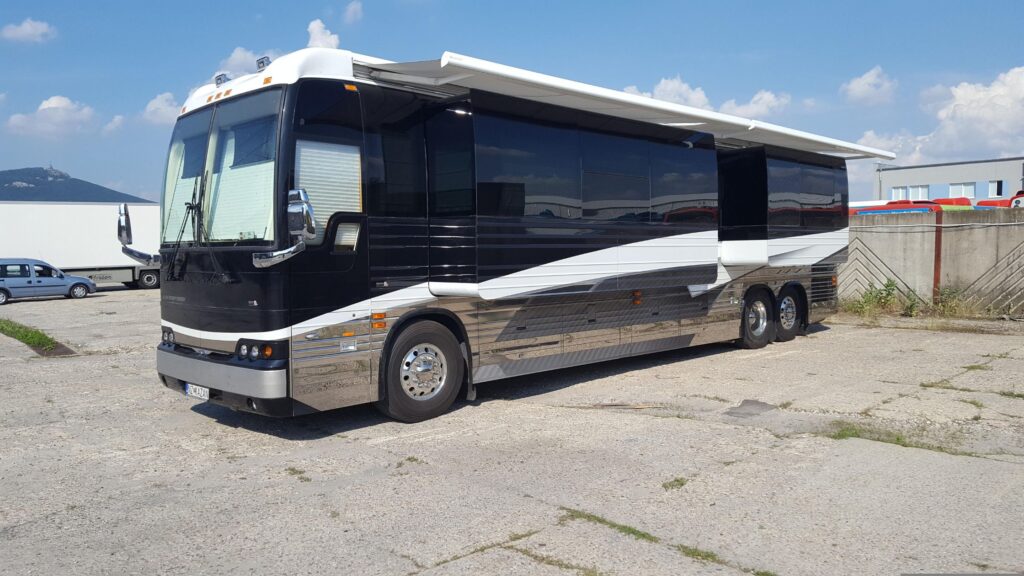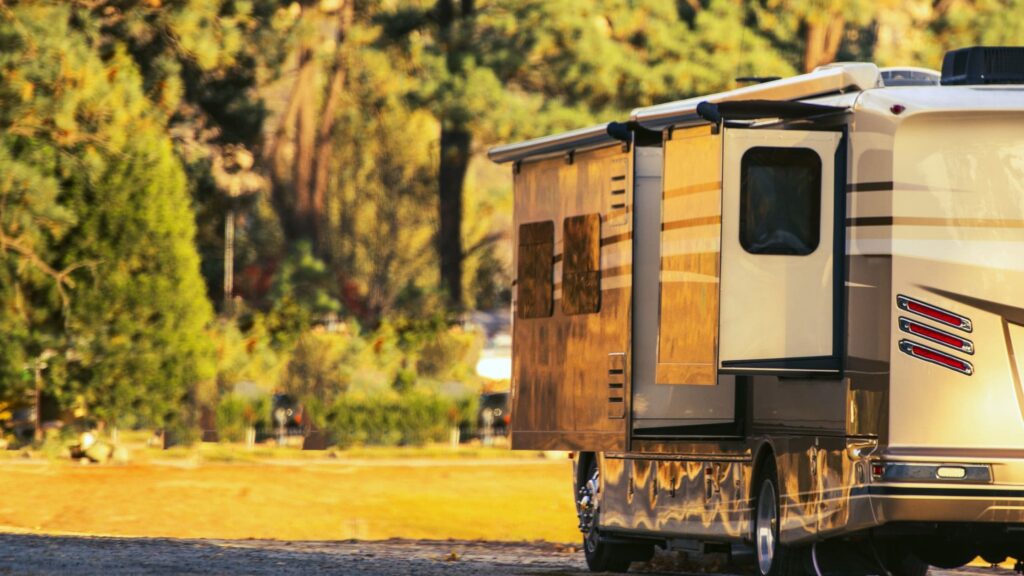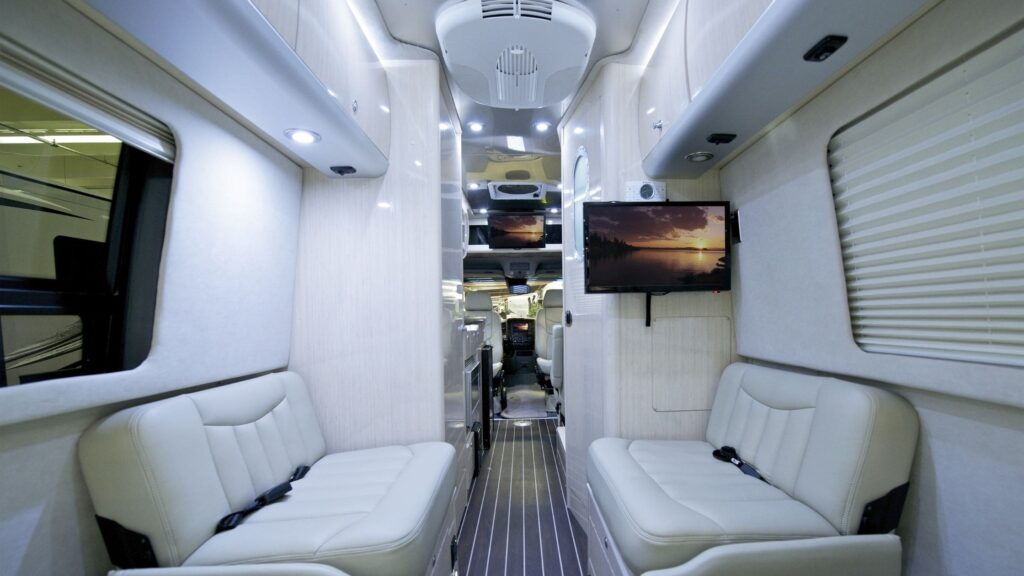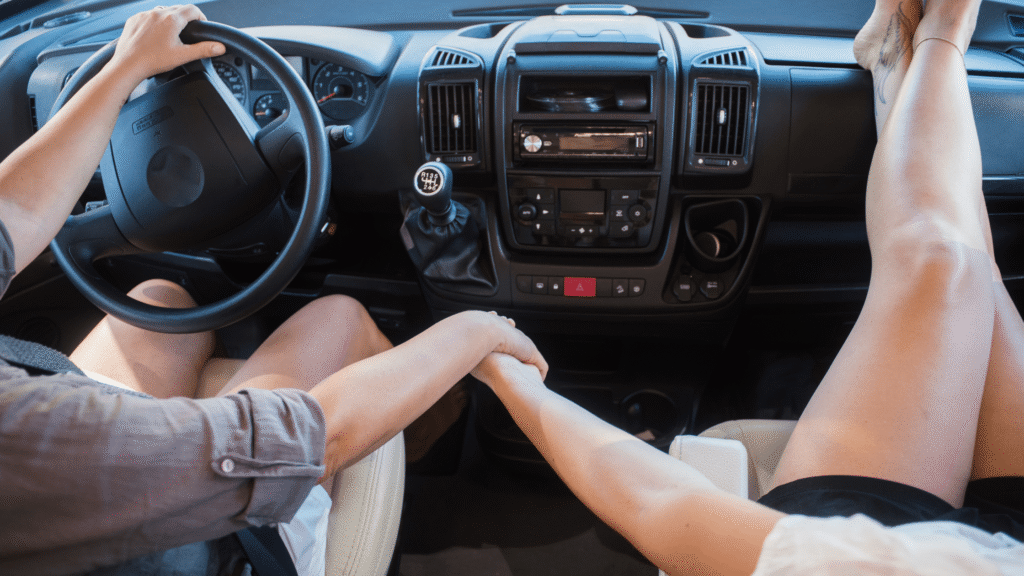If you’re weighing up the idea of buying a motorhome or thinking about when to sell, understanding what’s driving motorhome prices right now is key.
There’s something about seeing your home in the rearview mirror and knowing you can stop wherever the map takes you. That’s the magic drawing more and more people in the UK toward motorhome travel.
In fact, over a third of adults now say they’re more likely to vacation closer to home, and that rising interest has kept motorhome prices high, even as supply chains shift.
In 2025, you’ll need around £25,000 to get into a reliable used model. That figure reflects not only growing demand but also higher material costs, newer vehicle upgrades, and the impact of van chassis shortages.
Some 2024 stock is being discounted, but manufacturers are already signaling higher price tags for 2026 models.
So if you’re after more comfort, better fuel efficiency, or just a good investment, it pays to know when to act. In this article, we’ll focus on what’s shaping motorhome prices today, how seasonal trends affect your timing, and what you can do to get the best value whether you’re buying, selling, or just exploring your options.
How Much Does a Motorhome Cost?
As of 2025, a new motorhome can cost between £40,000 and over £250,000 depending on the vehicle type, features, and brand. If you’re more focused on the used market, expect to pay between £25,000 and £150,000+, depending on condition, mileage, build quality, and layout.
Used motorhomes continue to retain strong value due to limited stock and higher conversion costs. Some discounted options still appear, one example is an Adria Active Duo campervan recently listed at £48,000 after a £17,000 reduction. Occasionally, four-berth coachbuilt motorhomes surface for around £25,000, but demand for these family-friendly models means they sell quickly.
Prices haven’t dropped significantly. Instead, most dealers report a stabilized price level that sits 15 to 30 percent above pre-2020 averages. That increase reflects embedded costs such as VAT, freight surcharges, and taxes associated with gross vehicle weight. These costs are now part of the long-term baseline for motorhome pricing.
What are the Average Prices for New Motorhomes?
Prices vary widely depending on the class, specifications, and manufacturer reputation. A-Class motorhomes sit at the top end of the market, while micro campers offer a more affordable entry point. Each class offers a different balance of comfort, features, and space, so your decision should reflect your travel needs, family size, and long-term usage plans.
- A-Class: Entry-level units start around £90,000. Mid-range builds usually range from £120,000 to £180,000, while premium models exceed £250,000. These vehicles often include larger living space, advanced heating systems, upgraded air conditioning, and more refined design.
- Coachbuilt: Entry versions begin at £50,000. Mid-tier coachbuilt motorhomes fall between £70,000 and £100,000, while high-end variants cost £120,000 or more. These motorhomes offer great balance for families looking for comfort, reliability, and modern facilities.
- Campervans: Budget-friendly models start around £40,000 to £50,000. Mid-spec conversions reach £60,000–£80,000, and top-end or custom-built options can climb above £100,000. Fuel costs and maintenance are typically lower due to their lighter van chassis.
- Micro motorhomes: Base vehicles cost about £24,000. Fully built turnkey options average £28,000–£35,000, though luxury micro conversions may surpass £40,000 depending on fittings and interior equipment.
Class A
Used A-Class motorhomes typically cost between £50,000 and £150,000+. If you’re looking for a five-year-old example with less than 30,000 miles, the average price is in the £80,000 to £110,000 range. These models appeal to those prioritizing living comfort, extended travel, and high-spec interiors.
Larger Class A motorhomes, those over 7.5 meters in length, often exceed 4 tons in gross vehicle weight. This places them in higher tax bands and may require a C1 driving license. That’s something you need to factor in not just during the search but also when calculating ongoing ownership costs. Larger appliances, bathroom layouts, and kitchen appliances often come as standard in these models, boosting the appeal but also adding to the initial and long-term price.
If you’re after space, road presence, and a sense of open-road freedom, Class A motorhomes are worth the higher price tag, but only if you’re ready to budget for their additional costs, including fuel, servicing, and insurance.
Class B
Class B motorhomes, often referred to as van conversions in the UK, sit in the midrange of the price spectrum. In 2025, used models typically range from £25,000 to £70,000 depending on age, condition, and conversion quality. This vehicle type is built on a compact van chassis, usually under 3.5 tons in gross vehicle weight, making it easier to park and maneuver than larger mobile home formats.
Because of their smaller size, Class B models usually offer lower ongoing costs. You can expect real-world fuel efficiency of 28–34 miles per gallon, which helps offset higher purchase price compared to older campers. Insurance costs are typically lower too, with premiums starting from around £300 per year, especially if you store the vehicle in a secure facility.
These models are especially popular with solo travelers or couples who want something more practical than a large coachbuilt motorhome. You still get essentials like a compact bathroom, kitchen appliances, and sleeping space, but in a more agile and efficient layout.
Campervan
Campervans remain one of the most versatile and in-demand motorhome options in the UK. Used factory-built examples with around 80,000 miles typically start from £35,000 in 2025. These include well-known brands like Volkswagen, Ford, and Mercedes, with each offering slightly different layout options, fittings, and engine types.
Higher-end examples like the Mercedes Marco Polo or Ford Nugget usually launch between £70,000 and £80,000 when new. However, by year three, you can often find these models for £10,000 to £15,000 less, depending on condition and service history. The drop in value reflects natural depreciation but also creates opportunities if you’re buying a motorhome as a long-term investment.
Campervans tend to offer good living space within a compact footprint. Many include pop-up roofs, rear kitchens, and built-in storage solutions that make them ideal for weekend adventures or even full-season camping. With lower road tax bands, solid build quality, and access to a wide service network, campervans give you a flexible, road-ready option without compromising comfort.
Automatic
Automatic transmissions have become more common across motorhome models due to shifting driver preferences, especially among people transitioning from cars. On average, an automatic gearbox adds 10–15 percent to the purchase price compared to a manual equivalent. For many, the convenience and ease of driving justify the higher upfront cost.
In 2025, used automatics start around £30,000 for older models. Mid-age examples—typically between three to five years old—are priced between £50,000 and £80,000. Nearly new automatics, especially those with mileage under 10,000, often sell for £80,000 to £120,000 depending on trim level, manufacturer reputation, and included extras like solar panels or upgraded air conditioning.
While automatics reduce the mental load during long-distance travel, they may carry slightly higher fuel costs and maintenance expenses. However, they also tend to hold their value better due to growing demand. If you plan to tour across mixed terrain or through congested areas, an automatic motorhome can make the overall experience smoother, more relaxed, and far more enjoyable.
Based of Berths
Motorhome prices vary significantly depending on the number of berths. The berth count doesn’t just reflect sleeping capacity, it often correlates with living space, features, and layout complexity. If you’re evaluating options based on how many people will regularly use the motorhome, the berth category can give you a helpful pricing baseline.
In 2025, average used motorhome prices by berth are as follows:
- 2-berth (£30,000 to £50,000): These compact models are ideal for couples or solo travelers looking for efficient fuel costs, limited parking needs, and easier handling.
- 3-berth (£35,000 to £55,000): An uncommon but practical format, 3-berth models usually include flexible lounge sleeping arrangements or a convertible dinette.
- 4-berth (£40,000 to £60,000): A popular family option, often featuring fixed beds, rear lounges, or bunk setups.
- 5-berth (£45,000 to £70,000): More space means larger chassis and added amenities like separate bathrooms and kitchen appliances.
- 6-berth (£50,000 to £80,000): These models maximize internal layout but may come with higher gross vehicle weight and road tax implications.
Coachbuilt
Coachbuilt motorhomes offer a solid middle ground between affordability and onboard comfort. Built on a van chassis with a custom living pod mounted to the rear, they are favored by families and long-distance travelers who prioritize both space and functionality. In 2025, used coachbuilt stock begins at approximately £30,000. However, for a well-maintained model from 2017 or newer, the typical price range sits between £55,000 and £85,000.
These models often feature fixed berths, full kitchen facilities, wet bathrooms, and additional storage space. The overcab design or low-profile roof options provide flexibility depending on how much headroom or aerodynamics you prefer. Many coachbuilts include desirable features such as solar panels, upgraded water tanks, and air conditioning systems, factors that can significantly increase their value.
Because coachbuilt motorhomes often weigh near or over 3.5 tons, you may also need to factor in a C1 license and higher insurance costs. Their popularity among UK travelers keeps resale value relatively strong, especially for those with documented services and manufacturer warranty history.
What Factors Influence the Cost of a Motorhome?
Several key factors shape the purchase price of a new or used model, including the size of the vehicle, its class, drivetrain configuration, and even its brand reputation. These variables don’t just affect the initial price tag, they also impact insurance, road tax, fuel costs, and long-term maintenance expenses.
When you’re buying a motorhome, it’s easy to focus only on the layout or fittings. But real value comes from understanding how gross vehicle weight, transmission type, and vehicle type influence your total ownership costs. You’ll also want to factor in depreciation, market demand, and how specific features like air conditioning or solar panels can affect both comfort and resale value. Whether you’re leaning toward a large coachbuilt motorhome or a smaller camper van, being aware of these details will help you compare models with a clear sense of financial commitment and practical suitability.
Motorhome Size and Class
The market is generally divided into A-Class, coachbuilt, and campervans (also known as Class B). Each category brings different pricing expectations, build quality, and insurance considerations.
A-Class motorhomes are fully integrated units, typically sitting at the top of the market. Their streamlined bodywork, premium interiors, and extended living space push average prices above £90,000 for new models. These motorhomes often exceed 3.5 tons in gross vehicle weight, meaning you’ll likely need a C1 license. That added size translates into higher road tax, fuel costs, and ongoing maintenance.
Coachbuilt motorhomes fall in the mid-range, usually starting around £50,000. Built on a van chassis with a custom living area attached, they balance space and price well. Their more conventional construction often means better availability and a wide range of options from UK and European motorhome manufacturers.
Campervans are growing in popularity due to their compact footprint and lower running costs. Prices for new conversions now rival those of mid-tier coachbuilts. Their appeal lies in urban mobility, improved MPG, and fewer restrictions on parking or weight.
Transmission Type and Driving Position
On average, opting for an automatic transmission adds between £5,000 and £10,000 to the purchase price. This premium reflects both higher build costs and increased demand from customers transitioning from automatic cars. While automatics may have slightly higher fuel consumption, many drivers value the reduced fatigue during long trips, especially in heavier vehicle types like A-Class or coachbuilt motorhomes.
Driving position is another cost variable. Most UK motorhomes are right-hand drive, but left-hand drive models, especially imports, can offer savings. Used left-hand drive vehicles may start around £10,000, but you need to budget roughly £1,000 for UK registration, road tax, and related expenses. New left-hand drive units are rare in UK stock and tend to begin near £80,000, with top-end models pushing past £200,000.
Berth Count and Layout
Sleeping capacity is more than a comfort preference—it directly influences a motorhome’s price point, layout design, and internal fittings. Whether you’re camping as a couple or traveling with kids, the number of berths shapes both cost and configuration.
Coachbuilt motorhomes with a fixed island bed typically cost 5–10 percent more than similar models with a rear lounge. That’s because fixed-bed layouts optimize the use of living space and eliminate the need to convert seating each night. These models also tend to offer more storage and integrated kitchen appliances, which further increase the price.
If you’re considering a luxury A-Class or premium coachbuilt, slide-out sections are now available in select European models. These slide-outs can add over £20,000 to the base price, but they significantly enhance interior space, something that matters if you plan to spend extended periods on the road.
Micro Motorhomes and Campervans
These compact vehicles typically start around £24,000 for the base van, with a conversion cost of approximately £4,500. Older examples, some over 15 years old, can be found from just £7,000, depending on condition and mileage.
Micro campers prioritize fuel efficiency and cost control. Many achieve over 35 miles per gallon, which helps reduce running costs when compared to heavier motorhomes. Their lower gross vehicle weight also means reduced road tax, simpler servicing, and more flexibility in parking.
While they may lack a full bathroom or permanent bed, newer conversions often feature smart space-saving design, integrated cooktops, and modular seating areas. For solo travelers or couples, this vehicle type delivers essential amenities without the higher purchase price or long-term insurance costs typically associated with larger motorhomes.
Optional Extras and Upgrades
Optional upgrades can significantly alter the final purchase price of any motorhome. These extras improve comfort, off-grid capabilities, and driving experience, but they come with a cost you’ll need to factor into your total budget.
A factory-fitted solar panel package typically ranges from £800 to £2,000, depending on wattage and battery integration. If you’re interested in more robust energy independence, aftermarket lithium battery and inverter systems can exceed £2,500.
Technology packages are also a key consideration. Reversing cameras and parking sensor bundles start around £400 and can reach £800 with full installation. Some high-end A-Class and coachbuilt models offer heated floors, which add approximately £1,500 but enhance winter touring comfort.
Other features like alloy wheels, upgraded bathroom fittings, and roof-mounted satellite dishes all influence cost.
Brand Reputation and Build Quality
Premium European manufacturers like Hymer and Carthago consistently retain 8 to 12 percent more of their value compared to mid-tier or high-volume brands. If you’re planning to resell in a few years, that difference in residual value can significantly offset your original purchase price.
What sets these brands apart isn’t just their name, it’s their build quality. Many top-end models feature solid-frame cabinetry, reinforced GRP roofing, and double-floor construction. These enhancements may add over £5,000 to the initial cost, but they also help prevent damp-related repairs and long-term wear. Materials, fittings, and the integrity of the van chassis all factor into maintenance requirements and overall cost of ownership.
If you’re buying a motorhome to use regularly or live in full-time, investing in higher-quality materials can save money over time. They reduce running costs, simplify repairs, and offer a better day-to-day experience on the road.
What are the Ongoing Costs of Owning a Motorhome?
Beyond the purchase price, motorhome ownership involves a wide range of ongoing expenses. These include insurance, taxes, servicing, fuel, and general maintenance. While individual costs vary based on vehicle type, usage, and amenities, it’s essential to calculate these before finalizing your decision.
Insurance is one of the most consistent expenses, with rates affected by storage, mileage, and driving history. Fuel costs can vary dramatically between camper vans and heavier coachbuilt motorhomes, especially when you factor in diesel prices and expected miles per gallon. Don’t forget vehicle tax and MOT requirements, which apply annually and are tied to gross vehicle weight.
Other costs include campsite fees, winter storage, and optional services like deep cleaning, valeting, or upgrading air conditioning and electrical systems.
How Much Does Motorhome Insurance Cost?
In 2025, average premiums range from £300 per year for smaller campervans to as much as £1,500 for full-time living coverage. Coachbuilt motorhomes typically fall within the £500 to £1,500 range, depending on the model and declared mileage.
The type of policy you choose also matters. Comprehensive plans often include coverage for interior fittings, kitchen appliances, awnings, and other fixed amenities. If you’re traveling often or storing your vehicle in public areas, you may need to increase your liability limits or add content insurance.
Storing your motorhome at a CaSSOA-rated facility can lower premiums by 5 to 10 percent. These sites offer secured perimeters, CCTV monitoring, and gated access, all of which reduce the perceived insurance risk.
What Taxes and Fees Will You Pay?
For motorhomes under 3,500 kg, annual VED typically starts at around £200. Heavier models, classified as PHGVs (Private Heavy Goods Vehicles) between 3,500 and 7,500 kg, generally fall between £165 and £325 per year. This range depends on emissions, fuel type, and overall classification.
If you’re buying a left-hand drive camper or mobile home from overseas, first registration can cost around £1,000. This includes Individual Vehicle Approval (IVA), number plates, and DVLA processing fees. These upfront expenses should be factored into your total purchase price, especially if you’re calculating long-term ownership costs.
How Much Will You Spend on Fuel and Mileage?
Most coachbuilt motorhomes average between 20 to 30 miles per gallon, while smaller van conversions tend to achieve better efficiency, typically between 28 and 34 mpg. On a full tank, that gives you roughly 400 miles of travel for every £100 of diesel.
Compared to a standard car, you should expect a 10 to 20 mpg penalty due to the added size, weight, and load of a motorhome. This extra fuel consumption becomes more noticeable on long routes or hilly terrain.
As a general guide, plan for around £0.25 to £0.35 per mile when calculating travel expenses. This estimate helps you set a realistic fuel budget whether you’re touring weekly, seasonally, or embarking on a longer family trip across multiple regions. Diesel prices, tank capacity, and driving habits will all influence your exact running costs.
What Should You Expect in Servicing and Maintenance Costs?
Servicing not only ensures safety but also protects the vehicle’s long-term value and comfort features like air conditioning, plumbing, and heating systems.
A typical base-vehicle service costs between £250 and £500 annually, depending on the vehicle type and condition. In addition, a habitation check—which covers gas systems, water tanks, and electrical fittings, ranges from £150 to £250. The required MOT adds a further £58.60 each year for vehicles over three years old.
If you’re traveling 10,000 to 12,000 kilometers annually, it’s wise to budget about £110 per month for routine upkeep. This estimate includes wear items like tires, oil changes, filters, and minor repairs.
How Much Will You Spend on Repairs and Wear Over Time?
If you’re driving frequently or covering high mileage across varied regions, the mechanical and interior systems will need regular attention. Damp damage, worn clutch assemblies, and air conditioning faults are common in older vehicles or those exposed to harsh weather.
To stay ahead of breakdowns, it’s a smart idea to set aside at least £500 annually as a contingency fund for minor repairs. However, more extensive issues—like full damp-proofing, engine repairs, or suspension overhauls—can easily exceed £1,000 depending on the vehicle type and age. Keeping your campervan in a covered space and performing routine checks will help reduce long-term expenses.
These costs vary based on how often you tour, where you store your mobile home, and how well you maintain the systems. If you’re relying on your motorhome for long-distance travel, preparation is key to protecting both your investment and comfort.
What is a Habitation Check and What Does It Cost?
A habitation check is one of the most important services in maintaining the safety and livability of your motorhome. If you want to preserve the value of your vehicle and ensure that systems like gas, electricity, water tanks, and heating are operating safely, this annual check is essential.
This service typically includes a gas leak test, ventilation inspection, water system review, and damp readings across the living space. The process usually takes a few hours and costs between £150 and £250 depending on the dealer or mobile service provider.
While it may seem like just another line item in your list of ongoing costs, a habitation check is crucial for catching small issues before they turn into expensive repairs. If your camper van is still under a manufacturer warranty, this check is often required to keep that coverage valid.
Do You Need to Pay for Storage or Extra Security?
If you don’t have a secure driveway or garage at home, you’ll likely need to budget for off-season storage. Parking your motorhome at a CaSSOA-rated compound typically costs between £400 and £500 per year, depending on the region and level of access.
To protect your motorhome from theft and reduce your insurance costs, consider investing in additional security equipment. Thatcham-approved alarms, wheel locks, and GPS trackers not only add peace of mind but may lower your annual premium by up to 20%.
Given the price tag of most motorhomes, and the growing demand for specific vehicle types like coachbuilt motorhomes and A-class models, securing your asset makes practical sense.
What One-Time Costs Will You Pay After Purchasing?
You’ll likely need to spend on accessories, setup tools, and preparation services. These include basic amenities like kitchen appliances and leveling blocks, but also more specific items depending on your layout, equipment, and camping preferences. If you’re buying from a dealer, valeting and handover costs may be bundled, or added separately as part of a premium delivery experience.
What Accessories and Equipment Will You Need to Buy?
Setting up your new motorhome means investing in equipment to make your vehicle comfortable, safe, and compliant with campsite requirements. While some used models might come partially stocked, most owners will find themselves needing to purchase essential items during the first few weeks.
Altogether, expect to spend around £800 to £1,200 depending on the number of people using the motorhome and the features already installed.
A typical starter kit includes:
- Cookware and kitchenware: Pans, utensils, cutlery, dish rack, and fire-safe containers.
- Bedding: Sheets, pillows, duvets, and mattress toppers sized for non-standard berths.
- Utility gear: Hookup leads, waste and fresh water hoses, and chemical toilet supplies.
- Stabilization tools: Leveling blocks and wheel chocks suited to your gross vehicle weight.
- Other basics: A collapsible step, cleaning products, and solar panel maintenance brushes.
What are the Costs of Professional Valeting and Preparation?
A full pre-handover valet usually includes a deep clean of the interior, sanitation of the bathroom and kitchen areas, and protective paint or upholstery treatments. For an added layer of presentation and resale value, you may also opt for a full machine-polish of the exterior shell.
These services typically start at £250 for standard prep packages. If you want a showroom-quality finish, including wax sealants and ceramic coatings, costs can exceed £400.
What Is the Resale Value and Depreciation Like?
Unlike a house, a motorhome is a vehicle, and its value decreases over time. However, some models hold their value better than others. Strong brands, consistent servicing, and documented habitation checks can preserve up to 65% of the original purchase price after five years of ownership.
Coachbuilt motorhomes and A-Class vehicles tend to depreciate more slowly, especially when well-maintained and equipped with sought-after features like air conditioning or solar panels. On the other hand, budget campervans with high mileage and limited facilities often lose value more quickly due to wear, demand shifts, and changes in emission standards.
To minimize long-term loss, store your mobile home properly, avoid heavy aftermarket modifications, and retain service history records. You should also research regional demand and market trends before resale, some areas or campervan types fetch higher prices depending on the time of year and recent motorhome prices in your state.
Are There Hidden or Unexpected Motorhome Costs?
After the initial purchase, you might still encounter expenses you didn’t anticipate. These often fall outside the standard running costs and can catch new owners off guard. One example is the growing number of low-emission zones in urban areas. Cities with ULEZ or CAZ charges may bill you £12 to £25 per day if your vehicle exceeds emissions limits based on its gross vehicle weight or engine type.
You should also factor in extra height charges on ferries, which apply to taller models like overcab coachbuilts. These can significantly raise the price of travel to destinations such as Ireland, France, or island-based campsites. If you enjoy festivals or motorsport weekends, many pitch fees include mandatory security or waste surcharges that increase your overall camping expenses.
These additional charges often aren’t listed on dealership pages or in reviews, but they can influence the total value of motorhome ownership. Always leave margin in your budget for these variables.
How Have Global Events Affected Prices?
Global events have created ripple effects across the supply chain, and those effects still shape the current price point. COVID-19, for instance, led to a sharp rise in demand as families searched for socially distanced vacation options. That alone increased new motorhome registrations by 33% across Europe.
However, it wasn’t just demand. Shortages in semiconductors and van chassis, especially for models built on Ford or Fiat platforms, caused motorhome manufacturers to raise list prices. Between 2021 and 2023, average price increases reached 15.4% and then 22.7%. This also affected available stock, with fewer dealer units on display and longer lead times for custom layouts.
Brexit further complicated import logistics for UK buyers, raising delivery charges and VAT on many EU-sourced parts. The Ukraine conflict tightened the supply of raw materials like steel and aluminum, which are critical for van-based conversions and camper design elements.
What are the Predicted Price Trends Going Forward?
Several motorhome manufacturers have already signaled a projected 3% to 5% price increase by 2026. Much of this pressure stems from the rising cost of raw materials and regulatory changes that affect conversion costs for van chassis vehicles.
Fuel costs and sustainability standards are also shaping the market. As more regions impose emissions-based taxes, models with diesel engines or outdated emissions classifications may lose resale value faster. Electric options are still rare in this segment, but the trend toward lower environmental impact will likely drive investment into greener alternatives.
Another factor is labor and logistics. Skilled trade shortages are affecting motorhome production, and shipping expenses remain high across the industry. Combined, these issues will impact everything from base vehicle availability to amenities like bathroom fittings, kitchen appliances, and solar panels.
If you’re buying a motorhome now, factor in the full price tag, not just today’s deal, but the anticipated value shift over the next three to five years. This helps you choose the right model with a better long-term return.
Should You Buy or Rent a Motorhome?
If you’re only planning to holiday for a few weeks each year, renting a motorhome might be the most cost-effective option. On average, short-term rental rates range between £80 and £180 per day. These fees typically include insurance, maintenance, and roadside assistance, meaning you don’t need to worry about vehicle registration, MOT, or unexpected repairs during your trip.
However, if you expect to travel more than eight weeks per year, or prefer spontaneous adventures—buying a motorhome may be a smarter long-term decision. The break-even point often occurs around nine weeks of annual touring when you factor in fuel costs, motorhome insurance, road tax, and other ongoing costs.
Ownership also gives you more flexibility in customizing the layout, choosing accessories like solar panels or kitchen appliances, and creating a mobile home that suits your family’s lifestyle. If you’re someone who values freedom and comfort on the open road, the investment can quickly start to make sense.
What are the Best Times of Year to Sell a Motorhome?
Spring is the best time to sell a motorhome, March through May typically sees the highest demand. During this window, customers begin planning summer road trips, and dealer inventories are actively refreshed. Many brands push spring promotions, and the market becomes competitive with buyers searching for both used and new motorhome models.
By contrast, autumn and winter often see reduced interest, especially after peak holiday periods. However, some campers still look for offseason bargains during dealer clearance sales. Used vehicle stock tends to be more available at the end of summer, when people offload campervans they no longer need.
These seasonal shifts can significantly affect your final price tag. Selling when demand peaks not only improves visibility on search platforms but also allows you to command a better price point, particularly for well-maintained vehicles with updated features or recent service history.
How to Sell Your Motorhome for Maximum Value?
First, gather all the relevant paperwork, proof of purchase, service records, MOT certificates, insurance history, and any documents related to motorhome costs or conversion costs. The more details you can provide about the vehicle’s history and upkeep, the more trust you build with potential buyers.
Condition plays a critical role. Deep-clean the living space, inspect the fittings, and fix minor repairs that could affect the price point. Upgraded equipment, such as solar panels, upgraded kitchen appliances, or extra berths, can enhance appeal, especially if you’re targeting families or couples who are new to motorhome ownership.
Pricing is equally important. Research models with similar age, mileage, and build quality. Consider the gross vehicle weight and chassis type, Ford and van-based conversions typically draw different audiences than A-Class or coachbuilt motorhomes. Think about what features people search for: air conditioning, alloy wheels, updated bathroom layout, or ample storage.
Working with a professional dealer or motorhome broker can help. Reputable brokers, especially those authorized and regulated by the financial conduct authority, manage the full process, photos, listings, viewings, and negotiating with customers. They understand the factors that influence resale value and can position your mobile home competitively within the market.
What are the Best Times of Year to Buy a Motorhome?
The best time to buy a motorhome is during late fall and early winter, typically between October and December. During this period, demand slows, dealers face stock pressure, and clearance pricing becomes more common. You’ll often see reductions in the purchase price, especially on models with older registration dates or leftover stock from the current year.
Inventory levels are generally higher after the peak summer season. Used campervans and coachbuilt motorhomes are frequently listed by private sellers looking to offload before the holidays or winter storage. Dealer lots also tend to include more options during this time.
By contrast, spring sees rising motorhome prices as demand climbs. If you’re looking for the best value, it pays to monitor listings, compare vehicle type options, and time your decision around stock turnover and seasonal pricing trends.
Conclusion
Owning a motorhome is as well a financial decision, and a lifestyle shift. Whether you’re buying, renting, or getting ready to sell, every choice you make affects not only your budget, but also how much freedom and comfort you’ll enjoy when you hit the road.
We’ve explored how timing matters, buying in the quieter months or selling during peak season can influence your final price point by thousands. But that’s only part of the picture. Costs like insurance, fuel, repairs, and campsite fees shape your long-term experience. And the type of vehicle you choose, from a nimble campervan to a fully equipped A-Class, changes everything from your maintenance needs to your storage space.
If you’re planning your next step, don’t just think about the numbers, think about how often you’ll travel, the kind of destinations you love, and the level of comfort you want along the way. When you’re informed about market trends, running costs, and what makes certain models hold their value, you’re better equipped to make smart, confident decisions.
We’ve been through the key questions together, and now it’s your move. With the right timing, clear priorities, and a bit of planning, you’re not just making a purchase, you’re unlocking new places, new memories, and a whole new way to travel.
